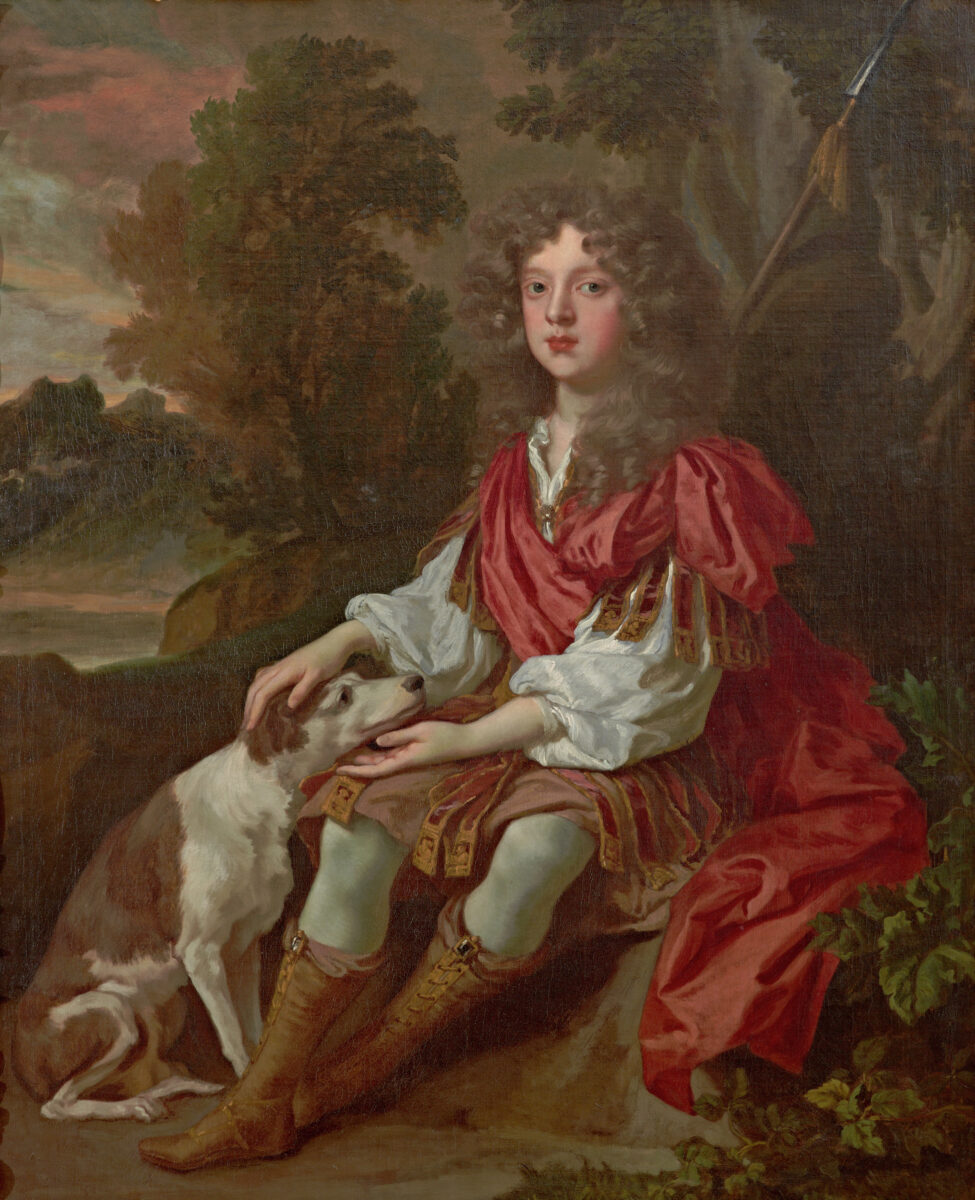The Restoration Portrait: Sir Peter Lely’s Portrait of a Boy in a Hunting Costume (ca. 1675)
Alexandra Zigomalas
Fig. 1. Peter Lely (Dutch, 1618–1680), Portrait of a Boy in a Hunting Costume, ca. 1675, oil on canvas, 50 1/2 x 40 1/4 inches, High Museum of Art, Atlanta, gift of Frances Floyd Cocke, 67.40.
Introduction
On October 10, 1664, an Englishman named Samuel Woodford wrote the following note in his diary: “… [that] not to be excused upon ye seal tomorrow & going with my cosen Beale to Mr. Lelys.”1 As a new and lonely widower, Mr. Woodford spent the summer and fall of 1664 with his dearest friends and “cosens,” Charles and Mary Beale. Woodford’s diaries reveal that Charles was a cousin of his beloved late wife, Alice, whom he had met through the couple in 1659.2 After Woodford and Alice married, the Beales welcomed them into their London home and gave them board.3 Woodford’s October diary entry—albeit brief—suggests that he had a very special relationship with the Beales because Charles brought him to the home of his wife’s teacher and most influential friend: the esteemed English portraitist Sir Peter Lely.
Mary Beale was a pupil of Peter Lely’s and spent much of her life working either for the court painter or in his shadow. Through Mary, Charles Beale brought many friends and acquaintances to visit the court painter’s studio and his home in Covent Garden. From the 1640s until his death in 1680, Peter Lely ran a busy studio where he primarily made portraits. Like his predecessor, Anthony van Dyck, Lely originally had set out to be a history painter. As a young man, Lely studied under Frans Pietersz. de Grebber in Haarlem and trained to create paintings of complex mythological, literary, and religious scenes.4 When Lely arrived in London, he found more success in creating portraits, as there was a larger market for portraiture in seventeenth-century London; however, Lely often showcased his love for history painting in his portraits by including mythological and literary themes, which his aristocratic patrons certainly could appreciate.
The Portrait of a Boy in a Hunting Costume (fig. 1) is no exception in Lely’s oeuvre. Lely portrays his sitter as a young hunter and places him in a fictional mythological landscape. The artist captures a moment of rest during the boy’s adventurous hunt. Poised on a rock, the youth relaxes his legs, his crimson red cape falling onto the foliage at his left. He tenderly caresses the head of his loyal hound, who gazes at him lovingly. While the dog is unperturbed by the viewer’s presence, the boy engages with the spectator; he invites us to join him in this imagined pastoral world.
It is unclear how this portrait came to be. We do not know the sitter’s identity. We do not know how or why his family commissioned this portrait. Perhaps they were friends of Lely’s—or friends of his friends, such as Charles Beale or Samuel Woodford. Maybe they knew Lely through his connections at court, or perhaps they had sought out the painter because of his reputation in England’s aristocratic circles. Despite the elusive identities of this portrait’s patron and sitter, the Portrait of a Boy in a Hunting Costume is a fine example of the types of portraits that Peter Lely created throughout his career and, more specifically, after the Restoration of the Crown in 1660.
Sir Peter Lely and the Market for Portraiture
Sir Peter Lely was born Pieter van der Faes in the town of Soest, Westphalia, in 1618 (fig. 2).5 Not much is known about Lely’s childhood, but as a young man, he went to Haarlem to work for and train under de Grebber. Sometime between 1641 and 1643, Lely moved to London to pursue a career as a painter and, at some point, changed his name to Peter Lely. His new surname was an homage to his family home, which had a gable with a decorative lily flower carved into it.6 Lely found success soon after he arrived in England. Around the time the painter settled in London, the most famous portraitist in the city, Sir Anthony van Dyck, died. Within a few years, Lely had stepped into Van Dyck’s role as England’s premier portraitist, and by 1647 he was painting portraits of King Charles I and the royal family.7
Lely worked consistently through a series of tumultuous events in English history: the English Civil War (1642–1651), the beheading of King Charles I (1649), the rule of Oliver Cromwell (1653–1658), the restoration of the monarchy (1660), and the reign of King Charles II (1660–1685). Despite working for both the king and his executioners, Lely managed to maintain and even grow in popularity from 1643 through 1680.8 On May 29, 1660, just one month after Charles II’s coronation and the restoration of monarchical power, Lely was appointed as the King’s Limner and Picture Drawer. This position made Lely the principal painter to the crown and meant that he was responsible for creating a recognizable image of Charles II. After years in exile because of the English Civil War, it was imperative that Charles display his power and legitimacy through art.9 In a 1672 portrait of the King, Lely depicts Charles II with all the grandeur and luxury expected of a monarch (fig. 3). Charles wears a rich green-blue velvet mantle over his shoulders that cascades downward and disappears into the background. He gently touches a black hat with large, flocculent, ostrich feathers, signifying both his wealth and fashionable nature. In addition to portraying Charles as powerful and stylish, Lely carefully captures the details of the King’s robes and badges, which represent the Order of the Garter and his duty to his kingdom. This painting exemplifies how Lely created portraits of the monarch that showcased the power, wealth, and legitimacy of the royal family.
-
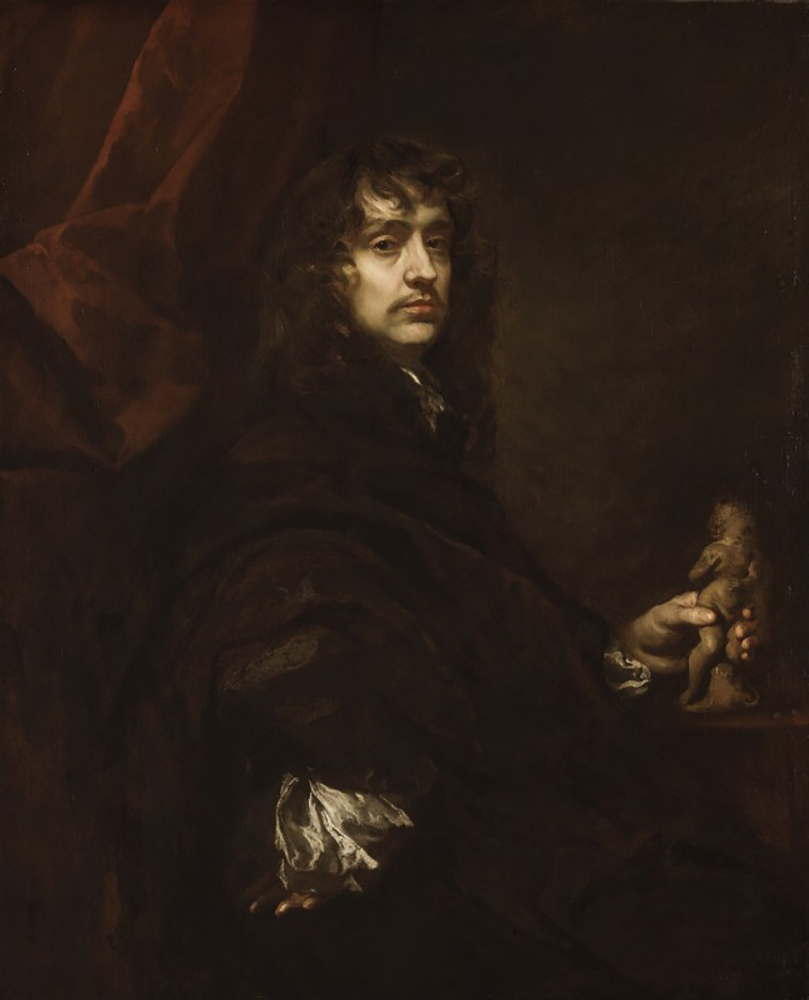
Fig. 2. Peter Lely (Dutch, 1618–1680), Sir Peter Lely, oil on canvas, ca. 1660, 42 1/2 x 34 1/2 inches, National Portrait Gallery London, Purchased, 1954, NPG 3897. Photo © National Portrait Gallery, London.
-
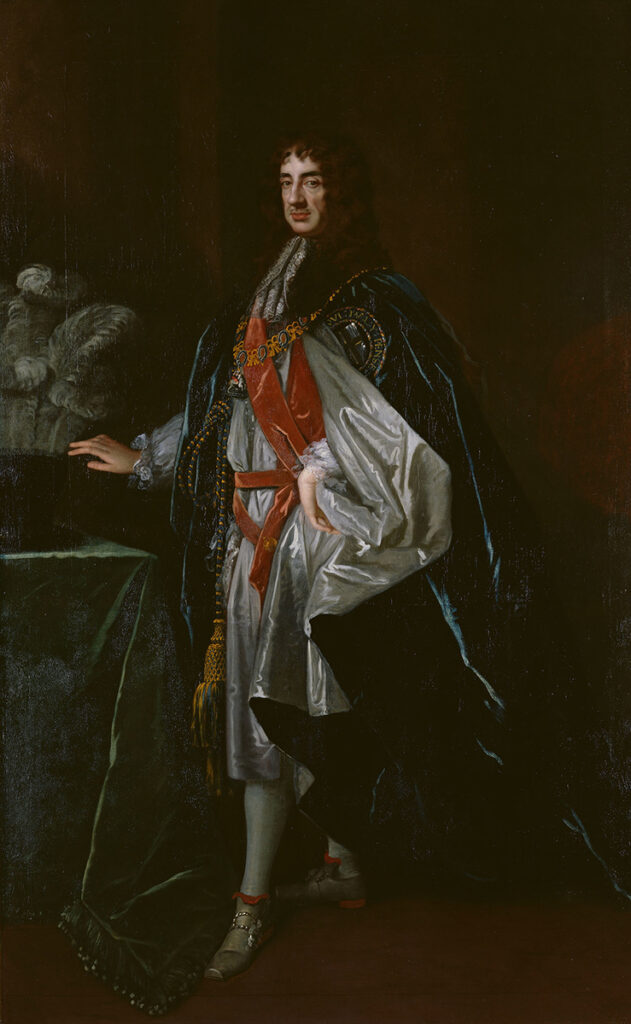
Fig. 3. Peter Lely (Dutch, 1618–1680), Charles II (1630–1685), ca. 1672, oil on canvas, 94 1/4 x 58 1/16 x 15/16 inches (support, canvas/panel/stretcher external) 49 3/16 x 42 1/8 inches (support [etc.], excluding additions), St. George’s Hall, Windsor Castle, Royal Collection Trust / © His Majesty King Charles III 2023.
With the restoration of the crown also came a restoration of the opulence and performance of court and aristocratic culture. Men and women in the king’s circles also desired to commission portraits that reflected their status and connection to the crown. By the end of the seventeenth century, London had a bustling art market that catered to patrons with both expensive and more modest tastes.10 Painted portraits made up a significant part of this market, and for the wealthy, there was an increased desire to have their portraits painted by the king’s favorite artists. As Charles II’s and London’s most popular portraitist, Lely used a variety of methods to keep up with this new demand. He ran a large studio with many assistants to whom he carefully assigned different tasks to make his process run smoothly and swiftly. Lely often used similar patterns and poses for his sitters, which he could rapidly replicate across many canvases.11 This method of expeditious production allowed Lely to cater to a high volume of patrons, and by 1662 his books regularly were filled a month or more in advance.12 The court painter’s technique was similar to that of Van Dyck, who would invite his patrons to his studio in the Blackfriars neighborhood of London. Those who were fortunate enough to commission a portrait from Van Dyck would sit only for a brief session, never more than an hour at a time.13 Before each session, Van Dyck’s assistants prepared his canvas and painting materials so that he could work as efficiently as possible. This allowed Van Dyck to see multiple patrons in a single day and to work on multiple portraits at once. Lely worked in a similar manner, catering to several patrons at any given time.
Lely also mimicked Van Dyck’s opulent, princely lifestyle. He entertained some of London’s most notable people, including the diarist Samuel Pepys and the scientist Robert Hooke, who both wrote detailed accounts of lavish dinners and holidays spent at Lely’s home.14 In addition to sparing no expense on his home or his guests, Lely was an avid art collector with one of the finest collections in London. According to Charles Beale’s diary entry of June 14, 1667, a Mr. Wemberg appraised Lely’s collection of paintings, drawings, and prints at ₤10,000 and praised his prints and drawings collection as the finest in Europe.15 As an artist, Lely achieved a rare type of success: he rivaled even his most important patrons in terms of wealth, status, and access to the art world. Lely filled his home and studio with rare works by the likes of Raphael, Rubens, and Bernini. Most importantly, Lely presented himself not as a portraitist to the aristocracy but, rather, as an aristocrat who painted portraits.
Lely’s Style: A Boy and His Dog
On view in the High Museum of Art, Atlanta, is one of the finest examples of Lely’s later portraiture. The Portrait of a Boy in a Hunting Costume depicts a young, presumably aristocratic boy and his loyal hound. They sit in a wild Arcadian landscape filled with verdant vegetation under a swirling pink-and-blue sky. An unidentifiable kingdom is visible in the distant mountains. The boy wears a rich, crimson robe that flutters off his shoulders and down onto the rock to his left. His blushing cheeks and loose curls underscore his youth. The dog rests his head on his owner’s thigh, happily waiting for his next command. Although we know a lot about Lely and his works, we are missing key information about the Portrait of a Boy in a Hunting Costume, including the biography of the sitter and details of the commission. However, based on what we know about Lely and his oeuvre, we can see how this painting is indicative of Lely’s style during the Restoration period.
Lely originally desired to be a history painter and often looked to Venetian painters—particularly Titian—for inspiration. In one of Lely’s early paintings, The Concert (fig. 4), we can clearly see his love of Titian’s pastoral landscapes. In this painting, Lely pays great attention to each individual’s facial expressions and figure. He creates different textures between the polished wood of the musicians’ instruments; the crumpled, satiny fabric of the women’s garments; and the feathery foliage. In the distance, trees twist up toward the sky, as if swaying along to the tune. Behind them appears an idyllic landscape. Although the colors in this painting are muted, Lely adds bright strokes of blue and red in the foreground, with the woman’s dress and the tent-like drapery that separates the two women and their dog from the musicians. Lely also includes a rare self-portrait of himself as the cellist. His long, thin fingers hold the bow and press on the strings with great precision, alluding to his mastery and dexterity as a painter.
-

Fig. 4. Peter Lely (Dutch, 1618–1680), The Concert, late 1640s, oil on canvas, 48 7/16 x 92 1/8 inches, The Courtauld, London (Samuel Courtauld Trust), bequeathed by Arthur Hamilton, Viscount Lee of Fareham, 1947, P.1947.LF.216.
In the Portrait of a Boy in a Hunting Costume, Lely creates a similar landscape with twisting trees that reach up toward the sky, a figure seated on a rocky outcrop, and the addition of a bright red garment to a more muted, earth-toned scene. The landscapes in both paintings could be classified as Arcadian, or idealized, rural landscapes. In antiquity, Arcadia was a bucolic region of Greece where it was believed that the god Pan dwelled.16 Distant from cities like Athens, Arcadia was a place where those living a pastoral way of life could be in harmony with nature.17 As did his contemporaries, Lely placed figures in pastoral, Arcadian landscapes to convey themes of serenity and harmony and to create a connection between their present moment and a distant, ancient past. In the Portrait of a Boy in a Hunting Costume, the Arcadian landscape signals both Lely’s and his patrons’ knowledge of ancient Greek and Roman texts and art.
The ancient themes of this portrait extend beyond Lely’s use of the Arcadian landscape setting. The young boy wears an almost Roman style of hunting dress. His tassels and red mantle mirror those of ancient Roman cuirasses, which soldiers wore in battle to protect their torsos. At this time in England, the nobility and aristocracy desired to convey their family’s noble bloodlines and “ancestral piety” in their portraits, as many saw themselves as the descendants of the ancient Romans who had invaded England.18 Although we do not know the identity of the sitter or his family’s history, the boy could be presented in this way to suggest his ancient noble bloodline.
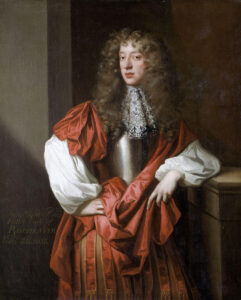
During a trip to London, I encountered the Portrait of John Wilmot, Second Earl of Rochester (fig. 5), a Lely portrait at the Victoria and Albert Museum that is strikingly similar to the High Museum’s painting. Wilmot looks as if he is the grown-up version of the High Museum’s young hunter. Wilmot and our young hunter both have the same soft, curly locks, defined cupid’s bow and fuller bottom lip, and eyelid shape. Most notably, they wear the exact same red mantle cape, tasseled garment, and white billowing shirt. The only difference is that Wilmot wears a breastplate to signify his military service and a lace cravat, which was a popular men’s fashion. It is possible that the Portrait of a Boy in a Hunting Costume was created earlier than 1675, perhaps in 1670, making the sitter a young man by the year 1677 when the Wilmot portrait likely was painted. Although there is no documentary evidence to prove that the High Museum’s painting is of a younger Wilmot, the similarities between the two portraits are so striking and show how important portraiture was at different stages of an aristocrat’s life.
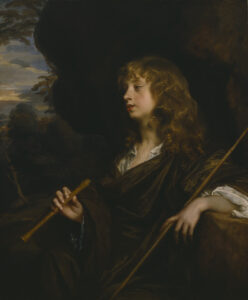
The High Museum’s painting also resembles other Lely portraits of young boys in pastoral settings. His A Boy as a Shepherd, of ca. 1658–1660 (fig. 6), shows a young boy dressed as a shepherd in a brown velvet mantle. His blonde curls fall gently onto his dark robe, illuminating his face against the shadows of the rocky outcrop behind him. He gently holds his walking stick with one elongated index finger that gracefully points downward. In his other hand, he holds a flute, arching his fingers over the instrument’s openings, as if he has just finished playing a tune. In Portrait of Henry Sidney, Earl of Romney, Lely renders another aristocratic boy as a young Adonis (fig. 7). However, unlike the High Museum’s hunter, Sidney activates the landscape as he forges forward with his loyal hound behind him. He gestures to the dog to pause as he looks to his left. When these portraits are placed in a row, one can easily see how Lely used patterns and poses: He places each boy firmly in the right-center portion of the canvas. The sky opens to the left, and each figure carries a stick or an arrow that creates the same diagonal across the picture plane. Lely infrequently painted children, especially not children who were the only subject and not part of a group or family portrait.19 This makes the High Museum’s painting part of a select subgroup of Lely’s portraiture.
Despite the convincing similarities between the High Museum’s painting and several others in Lely’s oeuvre, there was once a question of attribution. In 1970, Oliver Millar and Douglas Stewart claimed that this was an example of Lely’s hand. However, two years earlier, art historians Roy Strong and Ross Watson had suggested that the portrait could be the work of Lely’s assistant, John Greenhill. In order to support Millar and Stewart’s claim, the High Museum had technical multispectral images taken of the portrait in the summer of 2020 with the help and guidance of the Michael C. Carlos Museum’s Chief Conservator, Renée Stein. Because Lely was so skilled and worked so rapidly, he rarely used underdrawings in his paintings. This was proven in a technical study that Tate Britain did in 2003.20 Unfortunately, because of the thick layers of varnish applied over many years to this painting, we could not see if there was or was not an underdrawing. Even though the results of our study were inconclusive, we have strong reason to believe that Lely created this painting.
In the Portrait of a Boy in a Hunting Costume, Lely demonstrates his love for pastoral landscapes and his mastery as a portraitist. We can see the striking similarities between this painting and his others of youthful boys in Arcadian scenes. Perhaps the most convincing similarities are between the High Museum’s subject and John Wilmot, with their crimson red capes and soft, curly locks. When he was alive, Oliver Millar was the authority on English portraiture and Peter Lely’s work. After my research experience, I have come to agree with Millar that this painting is, in fact, one of Lely’s finest portraits.
Selected Bibliography
Alexander, Julia Marciari. “A Dutch ‘stranger … on the make’: Sir Peter Lely and the Critical Fortunes of a Foreign Painter.” In From Strangers to Citizens: The Integration of Immigrant Communities in Britain, Ireland, and Colonial America, 1550–1750, edited by Randolph Vigne and Charles Littleton, 127–132. London and Brighton: The Huguenot Society of Great Britain and the Sussex Academic Press, 2001.
Barber, Tabitha, ed. British Baroque: Power and Illusion. London: Tate Britain, 2020.
Campbell, Caroline. “Becoming Peter Lely.” In Peter Lely: A Lyrical Vision, ed. Caroline Campbell, 12–26. London: The Courtauld Gallery in Association with Paul Holberton Publishing, 2012.
Eaker, Adam. “The Scene of the Sitting in Early Modern England.” Journal of the Association for Art History 41, no. 4 (September 2018): 650–679.
Gibson-Wood, Carol. “Picture Consumption in London at the End of the Seventeenth Century.” The Art Bulletin 84, no. 3 (September 2002): 491–500.
Jones, Rica, and Joyce H. Townsend. “Man Playing a Pipe, c. 1648, by Sir Peter Lely,” London: Tate Britain, 2003, https://www.tate.org.uk/about-us/projects/tudor-stuart-technical-research/entries/man-playing-pipe-c1648.
Millar, Oliver. “The Restoration Portrait.” Journal of the Royal Society of Arts 109, no. 5058 (May 1961): 410–433.
Robinson, John Martin. “Ancestral Piety.” In The British Face: A View of Portraiture 1625–1850, edited by Donald Garstang, 11–13. London: P&D Colinaghi & Co. LTD, 1986.
Ruff, Allan R. “The Classical Origins of Arcadia.” In Arcadian Visions: Pastoral Influences on Poetry, Painting and the Design of Landscape, 1–14. Oxford: Oxbow Books, 2015.
*For this paper, I used the following unpublished archival materials from the National Portrait Gallery’s Heinz Archive and Library. I would like to thank the staff, and particularly Vanessa Knight, for their help:
Jeffree, Richard. Extracts of Samuel Woodford’s Diary, 1664–1665. The National Portrait Gallery Heinz Archive and Library, London: Drawer 2, Blue Book. *The original diary is housed in the Bodleian Library: MS. Eng. Misc.f. 381.
____. Extracts of Woodford’s annotated copy of Paraphrase upon the Psalms of David. The National Portrait Gallery Heinz Archive and Library, London: Drawer 2, Blue Book, page 4, XVII. *The book can be found in New College, Oxford, MS 9494.
____. Extracts from Charles Beale’s 1677 Diary. The National Portrait Gallery Heinz Archive and Library. London: Drawer 2, 16. Blue Book, page 35, LH 114.
